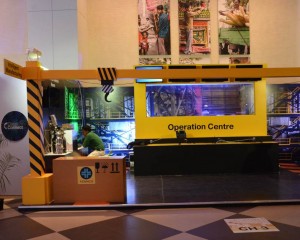
Horizontalization of Industries through IoE
Every industry analyst report, which you come across today, predicts huge business opportunities through IoT/IoE. Miniaturisation driven advances in sensor technology, advances in mobile technology/smartphones, Video, Data in motion, Analytics and Cloud Computing are some of the enablers for IoE.
The world will consume the outcomes of digitisation through a slew of new generation of apps, delivered through a new generation of ever powerful smart handhelds. We have already seen an exponential increase in number of app driven new businesses and product ideas, which have been funded in the startup eco system over past three years.
One can apply IoE principles to find solutions on the supply side for optimising the current processes, improving efficiencies, optimising the supply chain, saving energy, optimising on human resources, through algorithmic processing of real time/time sensitive data. Or one could also use the IoE to create new demands, by creating new and innovative products and services, by completely disrupting existing business models and changing existing paradigms (e.g., OLA disrupting taxi services market). It is typically easier to justify investments on the supply side, since it is easier to show ROI through savings or optimisation of existing business. The CAPEX and OPEX investments required on the supply side is generally a fraction of net savings accrued over number of years. However, supply side apps tend to plateau on the ROI over time.
Companies such as AirBNB and OLA have shown that incumbent businesses can be completely disrupted by changing the rules of the game. Traditional hospitality industry operates in an environment constrained by regulatory, tax, labor, real estate laws and one’s ability to own large and prime real estates. All of these contribute to a set of constraints. By taking the best of Web technologies, Mobility and Social – Airbnb changed the basic paradigm of the hospitality segment. It became an aggregator of services through an app, instead of owner of the assets needed in this segment. Airbnb does not play into the same constrained environment and is also not subjected to the same set of rules or metrics of success. Just as YouTube transformed the video segment by allowing anyone who had a camera or any other recording equipment to produce and share a Video, Airbnb is transforming hospitality segment by converting everyone and anyone who has a piece of real estate, into a service provider in a the hospitality business segment. Both these companies are using the same set of tools – Web, Mobile and Social to create new opportunities for large number of people spread out across geographies. Airbnb has brought travel and tourisms within the reach of large masses who could not afford it earlier by significantly reducing the travel costs. Another aspect that these companies changed completely is the real time nature of the customer feedback to the provider and it’s direct linkage to the business outcome. The feedback is instant and widely shared across its entire customer base.
Such apps based services, has the effect of horizontalization of services. Once you have captured the customer base, you can add providers to provide different services to the same set of customers, through similar transaction/payment models and consistent user experiences. OLA’s foray into food distribution is a good example of this. OLA is horizontalising from Taxi to food business with ease.
Similar concepts are playing out on the manufacturing floor too. According to the American Society for Quality, by December 2013, about 13% of the manufacturers had adopted smart manufacturing, of those who adopted smart manufacturing, 82% reported increased efficiency, 49% reported improved product quality and 45% reported improved CSAT. McKinsey estimates about 38% of manufacturers today are applying some sort of “smarts” on their factory floors.
Digitisation of manufacturing and IoT has the potential to completely disrupt and change the manufacturing paradigm. Digitisation and IP Sensor technology is bringing about the integration and consolidation of the physical devices and the logical processes. IP enabled Sensors and connectivity of existing manufacturing equipment to the IP network also enables IT/OT integration; dismantling the silos that existed between the IT and OT systems. This brings about tremendous level of flexibility and visibility into the manufacturing process. The Sensors, the devices and the process, together defines the complex logical-physical manufacturing floor. Integrate that with real time supply chain visibility and automation and it opens up a slew of new possibilities in on-demand manufacturing. The Manufacturing asset – the manufacturing shop floor can now be completely separated from the end product, or in other words, you can take a manufacturing floor, apply a new process and supply chain and convert the same into a totally new product -producing manufacturing plant! This means, we will very soon see a horizontalization of manufacturing – the manufacturing app, the plant, the process and real time supply chain automation = new product and each one of these entities can be owned by different owners….
Today manufacturing IoT applications can bring down your factory rejig times from months to weeks. It used to take months to rejig a factory to manufacture a different car model, now it takes a few weeks to do so. It is not unconceivable that in near future, IoE will be able to convert the same basic manufacturing infrastructure in to a manufacturing unit capable for producing completely different goods, dynamically and almost in real-time , based on demand…. “My factory manufactures tents today, but my IoE app can make it manufacture Umbrellas tomorrow….” This will be Airbnb – isation of factories…. The owner of the infrastructure and producer of the product may not remain same….
In our life time, I am sure we will see a day when an Amazon, Snapdeal or FlipKart equivalent will allow us to go on line and design to order our car – completely customised to personal preferences, maybe built on the base platform of our choice, but customisable with slew of options – delivered within 48 hours and payment on delivery!
5 Comments





Hi Amit,
Analogy of Ola moving into other “service” offerings and manufacturing offerings around “Process/Service” being able to change in quick time along with “Manufacturing asset – the manufacturing shop floor can now be completely separated from the end product, or in other words, you can take a manufacturing floor, apply a new process and supply chain and convert the same into a totally new product -producing manufacturing plant!” is well brought out, considering it is producing the output (New Product) using the same Machines and Infrastructure(and I am guessing you mean the same aswell)
Any process activity in Industries or Economic activity powered by Enterprise Apps or Web Scale Apps are increasingly looking at “Containerization” enabling users to isolate processes from the operating system and each other, allowing for microservices-based application(composing of hundreds of modules built around related business capabilities and fully independent, tied loosely through a API).
Good article here https://blog.openshift.com/building-agile-web-scale-applications-using-openshift-3/
Your point on ROI easily achievable for Supply side: here may be, the Financial Planning & Analysis, Unit economics costing, Revenue forecasting with likely Gross margins and Risk Management to be worked out prior to producing “New Product” by “Lifting the same shop floor and changing the supply chain and other processes etc”.
Hi Amit,
sounds interesting! Would love to get more details on this as some of the terms like IoE etc and am not familiar with. But the concept itself sounds interesting!
Disruptive business models are here to stay. Your thoughts provide a very good perspective on the possibilities that IoE can drive on the supply side and as well create entirely new demand centers.
Thats an interesting view. I think IoE and Cloud / Big Data are together in making that industry virtualization at a macro level. But to achieve that there are industry specific low level components on the IoE end – such as the right data models above IP layers. We have been doing some Energy Demos using our Open Standards based IoE (Internet of smartEnergy?) architecture on Cisco gateways as well. Such as the upcoming SEP2 show in Palo Alto (www.sep2expo.org)
Hi Amit,
These are very interesting observations you have made. It helps strengthen the business case for IoT/IoE. Economies of scale accruing from horizontalization of industries gives enterprise businesses a good ROI picture that makes it easier for them to push deployments.
We have similar observations in the industrial sector. Industrial OEMs servicing multiple disparate industrial sectors such as Power & Energy, Oil & Natural Gas, Manufacturing process automation etc are looking at common IoT/IoE architectures and deployments that could help service all these segments through a single investment. In a way, this is also horizontalization of IoT/IoE given the disparate nature of services required in these industries.